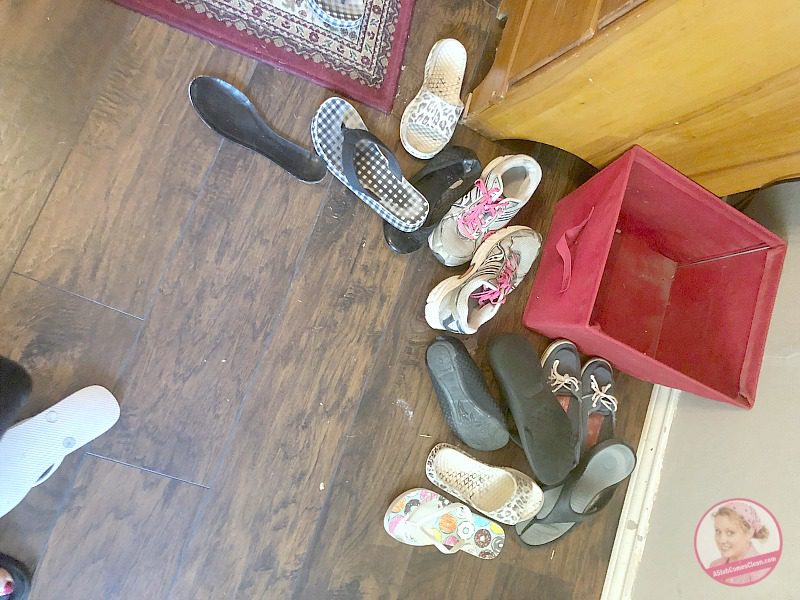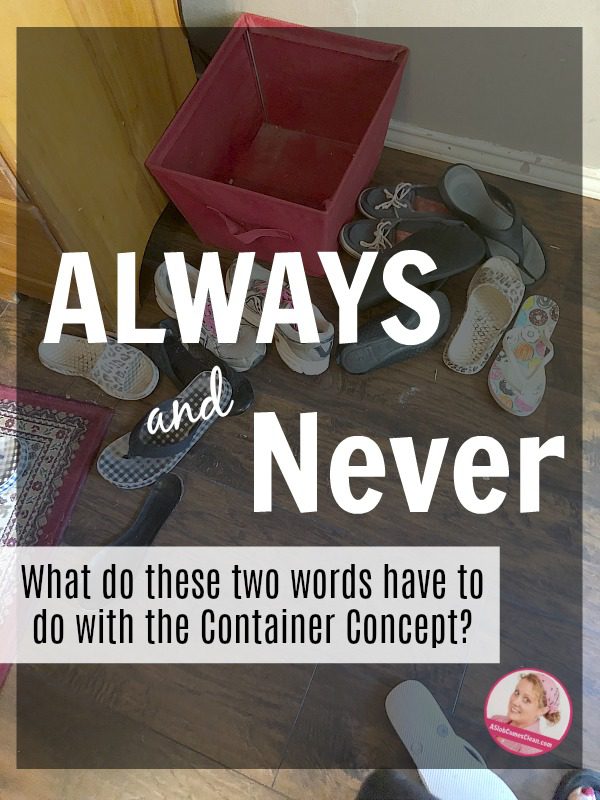
My mother once told me (once that I remember) to stop saying always and never.
Evidently, I said those words often. And incorrectly.
I’m sure she made this suggestion after I told an overly dramatic story that didn’t actually meet the qualifications of always and never.
Since very few things meet those qualifications.
I’m 44 now, and was probably 14 at the time, but I still struggle to not overuse these two words.
But I’ve decided to view this struggle as a good thing.
When I catch myself being overly dramatic and incorrect about always and never situations, I gain a little understanding. A little perspective on the alwayslessness or neverlessness of the thing that’s driving me crazy.
I spoke at my church’s group for young moms recently. One of my best friends from the days when I was a young mom is now our church’s preschool minister, so she was there for the meeting, too.
I referred to her a lot while I talked about decluttering.
She is the friend I’m talking about when I say that I always knew it was possible to have an always clean house because hers was always clean.
(Notice three uses of the “a” word in that last sentence . . . )
She’s also the friend I picture when I share the hypothetical story about the person who used containers correctly (as limits) while I used them as places to overstuff things.
She’s the mom with the perfectly cute and always neat craft cabinet.
Except her kids were always making crafts consistently.
Which means there were times when crayons and scissors and glue weren’t in their designated buckets.
So even though every time I saw her craft cabinet, things were neatly in their proper places, using the word always doesn’t work.
The main reason my craft closet never looked like hers was that I didn’t understand limits. I didn’t know that each crayon bucket, each scissor basket, and each bead box was a container. A limit on how many of those things I could keep. I especially didn’t understand that the shelf upon which these buckets and baskets sat was itself a container. A limit.
So even when I did put things away, it never looked right. I simply had too much stuff.
Now I understand “contain”ers and have decluttered like a maniac. I have places for (almost) everything.
But I sometimes still get jealous that my house doesn’t look like hers.
I’m not even talking about décor (which she is a master of, and I struggle to care about at all). I’m talking about how I never see scenes like this in her home:

That’s a pile of shoes by my own back door.
This pile made me think about the always and never concept.
Pre-Deslobification Me would have whined that solutions like shoe shelves never work for our family.
Pre-Deslobification Me would have wondered how solutions like shoe shelves always work for other families.
But in shoe shelf situations, there are no nevers or alwayses. There can’t be. Shoes must leave the shelves to be worn and go back on the shelves when they come off feet.
In craft closet situations, there are no nevers or alwayses. There can’t be. Scissors must leave the craft closet to cut things and go back to the closet when they’re done cutting.
So even in a house where things get put back into their places immediately, always and never don’t happen.
Putting back happens.
It’s the putting back that makes a space look good. The putting back keeps things under control.
But putting back equals transition, and the fact that there is transition time means there’s no always.
So how do I keep my own spaces under control?
I put things back. And then they look good again.
It’s the transition between “out of place” and “back in place” that’s the kicker.
As long as I only have what will fit on the shoe shelf, shoes that aren’t on the shelf are just shoes in transition.
In an ideal world, people in my house would personally put their own shoes on the shelf as soon as they take them off of their feet.
It’s always true that I never live in an ideal world.
I don’t notice when or where shoes leave my own feet. And either by nature or by nurture, the people who live with me have similar issues.
But as long as I have embraced the Container Concept and decluttered to the point where all our (current season) shoes will fit on the shoe shelf, I only have to work on the transitions.
Since I’ve decluttered to the point that I have places for (almost) everything, I’m forever amazed at how much easier it is to get the house picked up. Really picked up. Not shove-it-all-in-a-closet picked up.
And realizing that my brain is very different from the brain of my friend whose home always looks great lets me skip over the self-loathing and just start moving the shoes over to the shelf.
It’s not that her stuff is always in place and mine never is, it’s that her transitions are much shorter. And they happen more often.
And they’re shorter because they happen more often.
If you’re new around here, and references to “contain”ers and shelves-as-limits and such boggle your mind, check out these key strategies below. And/or get my book(s) to learn what I’ve learned, hopefully a lot faster than I learned it.
Containers and Limits and How They’ll Change Your Life Podcast
Ooooohhhh, “Container” Now I Get It
Getting Rid of Glasses I Know I Love – The Container Concept in Action

I love this post. I’ve been trying to figure out the difference between picked up and decluttered. This points out that sufficient decluttering makes picking up possible. And not just “shove-it-all-in-a-closet” picking up. Picking up is easy if you do it constantly. Never leave a room without carrying something with you.
I’ve realized I’m half way between Dana and her always organized friend. I have to have some stuff “out” to draw my attention to doing the work it involves – bills to pay, recipes for the week’s dinners, “to-do” lists, things that need to go to the car, etc.
I generally have a place for everything. The things I have “out” to work on are tidied up when I’m not in the midst of working on them. I do put stuff away when the task is done. And I do move things out of the house quickly.
I also can easily stash this stuff behind closed doors when needed for a higher level of picked up for planned guests!
I have used Dana’s tips to my great advantage in decluttering my own house but the best thing I have learned is a new perspective on the “slob brains” of some of my family members. I could never understand how they could so easily ignore the gigantic messes they make and live with. Ever since she posted an “after the after picture” picture showing that she had totally tidied a room up, thought she was done but didn’t notice a months old pumpkin until she saw it in the after picture, I have gained a new level of understanding.
I recommend A Slob Comes Clean to so many people in so many situations that I think some of them think I’m getting a kick back of some sort. Nope, I just know Dana is spot on about so many things that will make their lives easier!
I think always and never could be used as a way to retrain habits. If you tell yourself “I ‘always’ put my shoes on the shelf when they come off” or “I ‘never’ have more than one pair of shoes out at a time”; it still might not be true 100% of the time, but it might increase the awareness of what’s happening to shoes (or clothes, or anything else) when they’re not in use.
Maybe by the door is your “container”. In Yiddish they might say “that should be your worst habit in life.” So we can pick and choose what our “containers” look like and when the limit is being hit. At the same token, sometimes what is tolerable can vary and not “always” according to someone else’s standards.
My father would take off his socks at night and throw them in the corner far away from the bed as though he was trying to make a throw from the 3-point line in basketball. In the morning he would pick them up and put them in the hamper (or maybe my mother did.) Sometimes we have unusual “containers”.
Loved this. Gave me lots of chuckles and caused lots of ‘What??” from my girls as I quietly and chuckle-y read it.
I especially LOVED the photo of the empty shoe basket (I assume) with all the shoes NEXT to it…as in INCHES away.
Perhaps you didn’t intend this to motivate me to declutter my kids crafts, but I recently bought a new craft organizer thing that lives in the livingroom (where crafting happens) kids have been good about putting things away into it. (Because there’s a place for everything and none of the spots are overstuffed).
Their overstuffed craft shelves in the office though, really need to be purged.
The thought of the friend who’s craft shelves are “always” clean except when in use reminds me how often I tell my kids “no” to crafting because I can’t get handle getting crafts off the shelf because it’s too cluttered.
Also I recently decluttered my kids shoe shelf’s so that it’s not a Tetris game to put them away.
I wouldn’t want to dig through everyone else’s shoes to find mine! I think the picture of the shoes is a good one. When your kids are grown and gone, you will MISS that pile of shoes! I’m definitely not one you should follow about neat houses, but our kids are grown now and don’t live with us, but I love seeing the pile of BIG and LITTLE shoes by our door when we have everyone over for a party or holiday gathering, because now there are 7 *little* pairs of shoes there too! And on those occasions, we just toss everyone’s coat into my computer room to get them out of the way. I live in Illinois and we wear coats for more of the year than you do in Texas! 🙂 Love your books and all your blog posts!!
Once when I was talking to my “normal” friend who “always” has a clean house, she told me that the whole family is trying to create chaos in our homes and we (mothers) always fight it by putting things back. I was complaining how I can never keep a pretty blanket on the couch because it gets dragged around the house. Apparently she deals with this too, but her transition time just happens faster and she is constantly putting it back. Here I thought it was magic.
I think the most useful thing I’ve learned from this blog for my life over all is, ‘whenever you happen to think of it is the right time.’ It works just as well for academics and job stuff as for house work. And I appreciate it as the space between always and never.
You are a true genius. Really.
Transitions. That’s the name of the game. Extremely helpful light bulb moment happening here. OPTIMIZE TRANSITION. I’m on it.
And so true about those two words.
Thank you! I have also wondered why other people’s homes always look great – like they have some magic or live in a different world than I do. But, as you say, it’s just quick and consistent transitions!
Thank you for defining container concept, clutter threshold, and visibility rule! They’ve helped me so much!